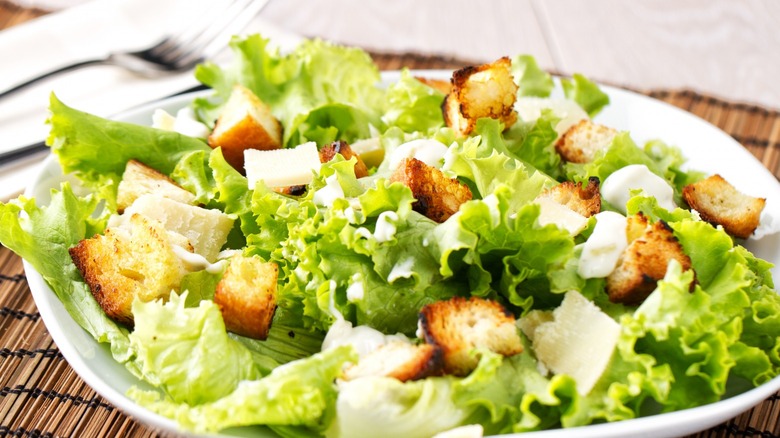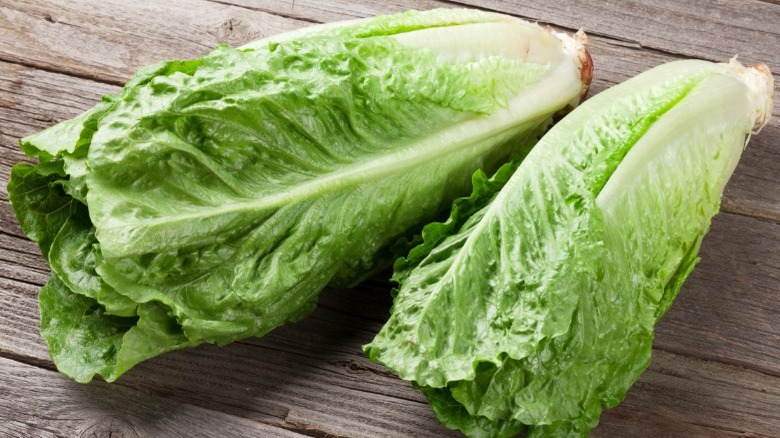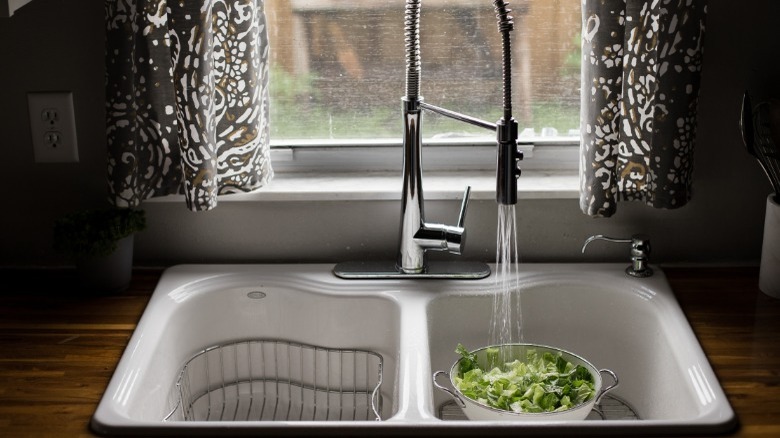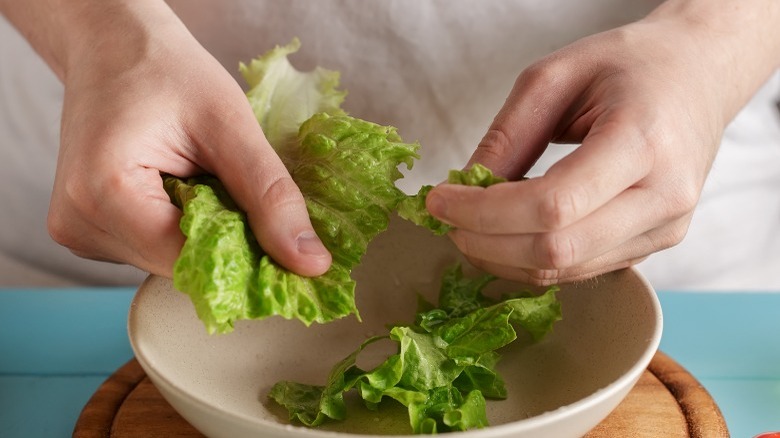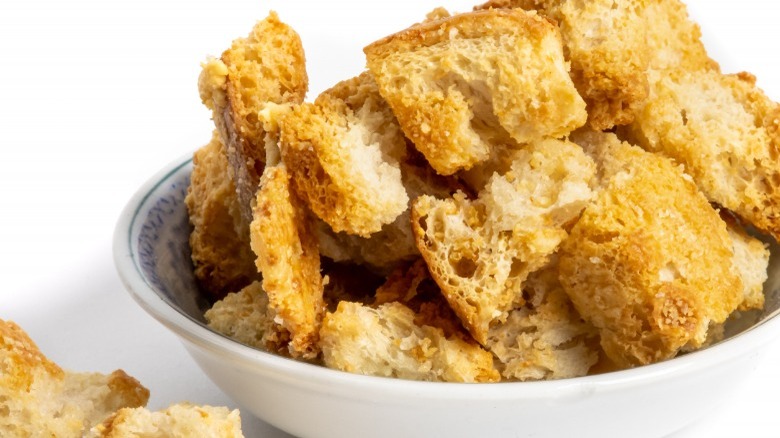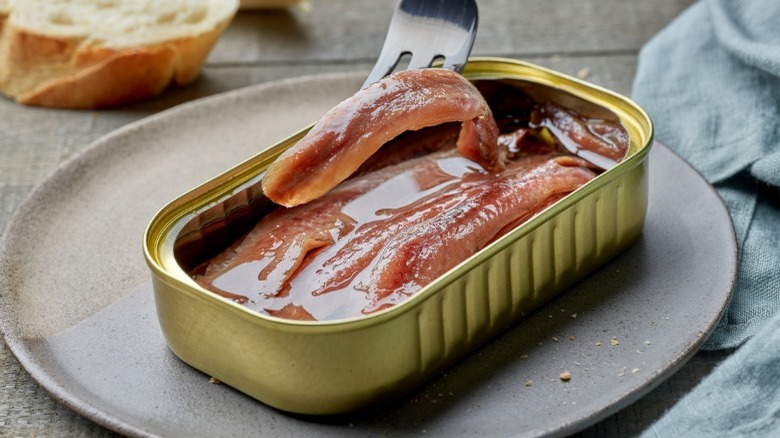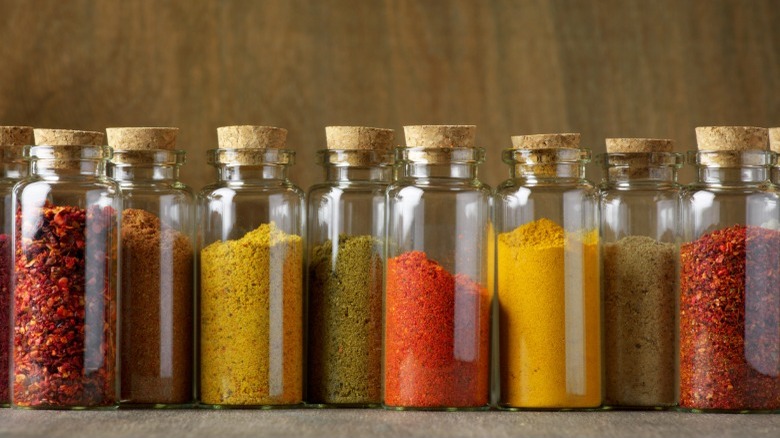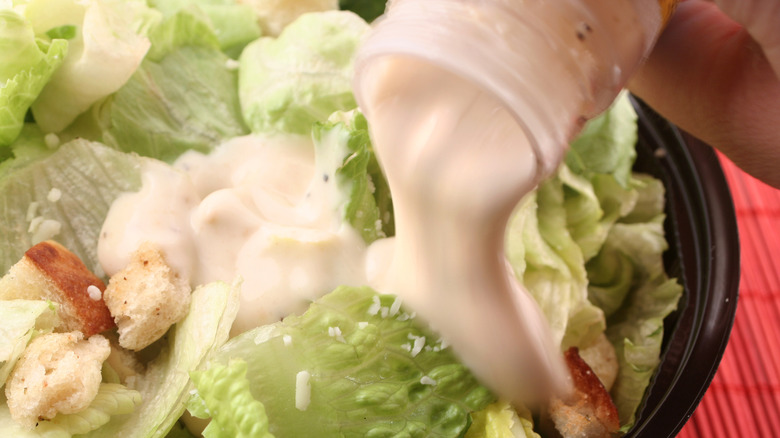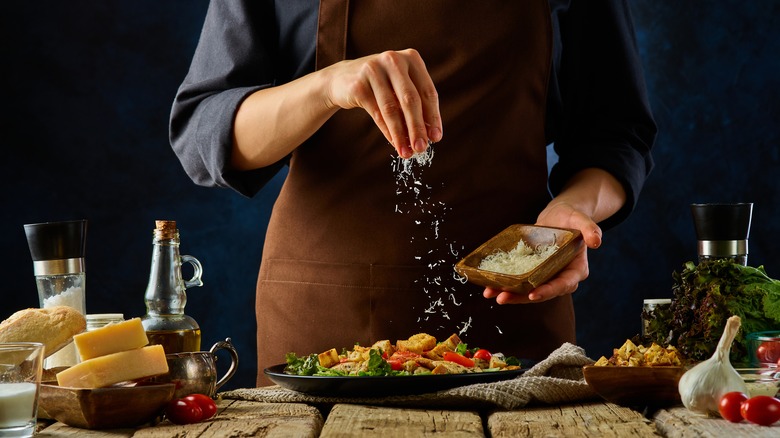Avoid These 11 Mistakes When Making Caesar Salad
A perfectly prepared Caesar salad sets the stage for a fine meal to follow, but if something's off by even just a little bit, everyone will notice immediately. Even though it's not a complicated dish, you must use the right ingredients and follow the right methods.
Contrary to what some may believe, it wasn't invented by Julius Caesar. The first version of the salad was served in Tijuana, Mexico, in 1924 and was created by an Italian chef named Caesar Cardini. Cardini's restaurant had a lot of American customers at the time. So, he quickly put together a finger food with items on hand: romaine lettuce, raw eggs, Parmesan, and a few other choice ingredients. The dish was a bona fide hit and soon evolved into a salad that's still on menus around the world. Its appealing, basic elements and unique combination of vibrant flavors caught on quickly. Julia Child was one of its earliest fans and had hers served tableside at Cardini's restaurant.
Since then, Caesar salads have been toyed with, rearranged, revamped, and assembled with various methods. While many of the versions are delicious, the traditional kind tastes best when it's not tampered with. If you're thinking about being creative or taking culinary shortcuts, you may want to think twice. These tips will keep you on track down the path of creamy, robust, and crispy deliciousness. Cardini got it right the first time, and you can, too.
1. Using the wrong lettuce
You may have seen Caesar salads made with kale or, heaven forbid, iceberg lettuce. However, romaine should be the only green you use to not throw off the taste too much. Romaine has a distinct, slightly bitter taste, while iceberg is on the blander side. Other greens should also not be used — arugula is peppery, kale has a much stronger, earthier flavor, and red leaf lettuce is too soft. And don't try to swap it out for spinach, either.
Combining romaine with other lettuces is another mistake because that will also take away from its natural flavor and classic presentation. Overall, romaine is the crunchiest of the bunch and holds up well to the heavier textures of cheese, croutons, and thick dressing. When shopping for romaine, look for firm, deep green hearts. The leaves should be about the length of your hand or longer and tightly packed. You can use precut romaine hearts if you like; just be sure to check the expiration date. Allow six to eight leaves per serving.
If you want Caesar salad and don't have any fresh romaine handy, either go out to buy some or consider making another kind of salad.
2. Forgetting to wash and dry the lettuce
It's important to be vigilant about washing romaine lettuce because dirt gathers close to the bottom. The best way to wash your lettuce is by first washing your own hands with soap and water. Then, you'll want to be sure that your sink is clean. Look over the romaine and remove any damaged parts — you can also throw out the outer leaves. Then, remove the other leaves from the base and rinse each one under cool water, checking the creases for dirt.
Another great method is to soak the lettuce leaves in cool water for 10 minutes, tossing them a few times with your hands to get an even wash. Next, dump the water they were soaking in or drain the sink and give the leaves a final rinse.
Wet romaine lettuce can be air-dried on clean dishtowels for about 30 minutes. You can also roll the leaves first to speed things up. If you're even shorter on time, a salad spinner will dry the lettuce even faster. Check the greens for moisture, and blot them with paper towels if you think they're still too wet. It's fine to put the lettuce greens in the fridge until you're ready to use them, but avoid doing this while they're damp unless you want a wilted Caesar salad.
3. Wrecking the romaine
Another mistake to avoid is using bags with precut pieces of romaine — this is different from the hearts. Whenever you buy precut lettuce, it won't be as fresh as the uncut kind. It's okay to use the prewashed hearts in a pinch, but using the precut ones is a mistake.
To avoid butchering a full head of romaine, take the time to cut it into salad-ready pieces. Slice the romaine lengthwise from top to bottom on a cutting board with a sharp, clean chef's knife. Cut out the bottom core or white part in a triangular shape. Then, cut each half into three or four vertical pieces and hold them together. Starting at the top, you can chop the first half into bite-sized pieces.
Some people prefer to serve Caesar salad with whole romaine leaves, which is fine as long as the lettuce is cleaned and trimmed. It's an elegant presentation as long as the leaves aren't too long — you should be able to see the edges of the plates. Another option is to tear the lettuce into bite-sized pieces, but the edges won't be as even.
4. Not making homemade croutons
Caesar salad croutons have been compared to icing on a cake, arguably the most delicious part of the dish itself. We're not talking about the ones that come in a bag. Choosing prepackaged ones is a shortcut that you might want to reconsider. Making homemade croutons doesn't take as long as you might think. To start, get a fresh loaf of sourdough or Italian bread. You'll want to start working on the croutons before you make the salad. Begin by cutting your bread into 1 to 2-inch pieces – tearing your bread by hand will make your croutons look more authentic.
Once the bread has been cut or torn, toss it with garlic-infused oil or regular olive oil, salt, and pepper. Bake them until lightly browned, and set them aside. Once they've cooled down, you can store them in an airtight container until your next salad. If stored properly, they can be used for up to two weeks. When you serve the salad, it's okay to let everyone know that you made the croutons yourself.
5. Not using real Parmesan
The right kind of cheese, like Parmesan, adds creaminess to a Caesar salad. If you pick a soft one like mozzarella, feta, or brie, you may just end up regretting it. The subtle, nutty, and fruity taste of real Parmesan cheese ties the other flavors together. However, not all Parmesan is made equal. Have you ever seen anyone dump powdered Parmesan cheese onto a salad? If nothing else, this is something you should avoid at all costs. Even if the container claims that the contents are 100% Parmesan, it could contain imitation products. Don't make this mistake with your Caesar salad.
Gourmet chefs know that the best-tasting Caesar salads are made with freshly sliced or grated cheese from a beautiful wedge of authentic Parmesan. American Parmesan cheese products are not aged as long as those made in Italy and can taste waxy. While it may be a bit harder to find, Parmigiano-Reggiano is worth looking for. While similar to Parmesan, to be considered Parmigiano-Reggiano, there are certain standards of production that set them apart. European Union law mandates that the latter must come from certain regions in Italy, and it is aged for at least 18 months. It's great for Caesar salads because of its distinctive, bold flavor. Wait to shred or slice it until right before serving, and again, don't buy it pre-shredded or blended unless it's a quality Parmigiano-Reggiano.
6. Not considering anchovies
Anchovies are an acquired taste, but unless you or anyone else being served the Caesar salad has strong objections, consider adding them. Often compared to sardines, these tiny fish have a savory umami taste and can elevate a Caesar salad. Some people love them, while others feel that they're too fishy and pungent. The trick with using anchovies is to find the right balance. If you add too many of them, the saltiness will overwhelm the other ingredients. Add just enough, and they will blend perfectly with the other flavors.
So, how do you buy anchovies, and how are they incorporated into the salad? For starters, you can find salt-cured anchovies in grocery and specialty stores, packed into tins with olive or sunflower oil. They can be used right out of the can, but the leftovers should be stored in a sealed container.
Although whole salted anchovies are harder to find and require more prep work, they are a much meatier and fresher option. Whole anchovies have to be deboned, de-finned, de-salted, and soaked. On the other hand, marinated anchovies are prepared with vinegar and have a milder taste. Which type you choose depends on the flavor you're going for and how much your palate can take.
7. Adding unnecessary spices
A traditional Caesar salad is served best with salt and pepper only. Anchovies will add saltiness, so using them makes sense — also the more anchovies you add, the less salt you need.
You should avoid using coarse salt because it adds unnecessary texture and has a stronger taste than regular table salt. As for the pepper, stick with freshly ground. The pre-ground pepper that you find in stores comes from whole peppercorns, and when ground pepper is exposed to oxygen over time, it loses its natural flavor. If you don't own a pepper mill, you should consider buying one.
Adding extra spices like chili powder or paprika to a Caesar salad is a big mistake, even if you're only trying to sprinkle on some color. Most colors have no place in this kind of salad as you'll be adding smokiness, sweetness, or other incompatibilities. In short, extra spices will throw off the flavor profile. Similarly, don't use a premade Caesar salad spice blend as some of them have added sugar and unsourced Parmesan cheese. Additionally, adding them to the croutons is another mistake.
8. Using bottled dressing
Bottled Caesar salad dressing cannot compare to homemade dressing. First, it has a lot of unnecessary ingredients. A lot of bottled salad dressing options contain unnecessary additives and preservatives that make for an unhealthy salad. Another issue with store bought salad dressings is the fact that you can't control the fat or sodium content like you can with homemade versions. While there might be some brands that are perfectly healthy and more on the fresh side, consider enjoying those on different salads. If you pour dressing straight from a bottle onto your Caesar salad, you run the risk of making it taste like a diner salad.
Making a bold, creamy homemade Caesar salad dressing takes about 10 minutes. All you need is mayonnaise, lemon juice, garlic, mustard, milk, and a few other pantry staples. Once you've gathered your ingredients, you'll just mix them in a bowl until they are nice and creamy. Stir in the milk and pop it into your refrigerator. It's really that easy.
Finally, when you get a craving for Caesar salad, you'll have some delicious, homemade dressing to pair it with. You won't be sorry you chose fresh over store bought — at least not for this dish.
9. Adding extra ingredients
These days, salads come with everything from yellow beets and gluten-free noodles to freshly sliced ahi tuna and dried fruit. A traditional Caesar salad can seem sparse by comparison, but the individual ingredients are packed with more than enough flavor. If you see a fully-loaded one on a menu that has those or more common ingredients like chopped bacon, chicken, or tomatoes, go ahead and try it. It may be a great lunch or dinner option and goes nicely with fresh garlic bread.
However, if you are expecting a classic Caesar salad, you may be disappointed. Similarly, if you are trying to make the perfect Caesar salad at home, stick with the basics. The reasoning behind this is simple. Each added item will change the flavor profile, and you'll lose the Caesar salad's personality. It's like adding fried eggs and ham on top of a perfectly grilled 100% sirloin cheeseburger. Each element tastes amazing on its own, but too much is just too much.
So, remember the original ingredients in a Caesar salad include romaine lettuce, Parmesan cheese, croutons, and Caesar dressing. The dressing is made with lemon juice, olive oil, Dijon mustard, garlic, and Worcestershire sauce.
10. Preparing the salad too far in advance
If you've ever found yourself hosing dinner for many people, you have probably worried about having everything ready on time. If Caesar salad is on the menu, you should avoid making it earlier in the day and sticking it in the refrigerator until you're ready to serve it. Instead, chop the lettuce a few hours before and keep it tightly sealed in the fridge without packing the leaves close together. You can use an air-tight bag or container for this. Romaine will wilt if it's left out on the counter for too long. Similarly, if you leave a dressed Caesar salad in the refrigerator for too long, it will also start to droop. The oils and juices in the dressing will absorb into the lettuce and make it less crispy.
And please, never refrigerate croutons. Anyone who's brought a leftover salad with croutons home and refrigerated it knows that those bread chunks become mushy and inedible. These can be made beforehand and stored separately in a sealed plastic container. So if you're short on time, prepare the lettuce, croutons, and dressing beforehand and store them separately. Have someone help you assemble everything just before serving time, or even better, impress everyone by preparing the salad tableside.
11. Putting it all together wrong
Caesar salad tastes best with chilled lettuce and looks most impressive in a wooden bowl. However, the type of serving dish is also up to your own preference. Putting together a Caesar salad with homemade dressing is a valued skill with specific steps, and many fine restaurants prepare them tableside. Just because you host people around your dinner table and not at a fine dining establishment doesn't mean you can't do the same. Consider preparing your salad when everyone has sat around the table to eat.
Now that you've learned which ingredients to use, which ones to leave out, and what to have fresh, this will make your salad tastier and fresher. Gather everything you've prepared and bring it all to the dinner table. Start by adding your cut-up lettuce into a bowl and giving it a good toss, along with some of your homemade Caesar dressing. Instead of waiting until the very end, try mixing in your croutons as well to get them coated evenly. Remember, everything should be lightly coated with the dressing, not dripping with it. Finally, you can serve the cheese on top or pass it around in a serving dish at the table.
